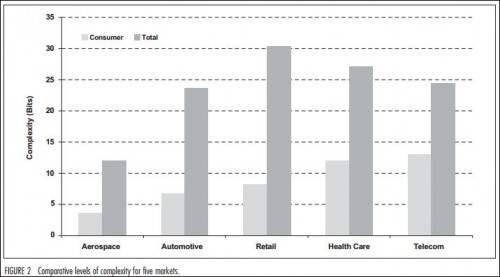From William Rouse (PDF) and h/t to Richard Vaughn:

Figure [2] summarizes an assessment of the complexity of five markets. Note that the complexity of health care is assessed to be 27 bits. This means that determining which nodes (i.e., enterprises) are involved in any particular health care transaction would require on the order of 1 billion binary questions. Thus it would be an enormous task to determine the state of the overall health care system.
Notice the ratios of consumer complexity to total complexity in Figure 2. Even though the retail market is the most complex market, the consumer only has to address a small portion of this complexity. The retail industry has been quite successful in managing the complexity of bringing a rich variety of products and services to market without consumers having to be concerned about how this cornucopia arrives on store shelves—or online outlets.
The telecom industry has the worst ratio, as anyone who has tried to call for vendor technical support for a laptop can attest. As a consumer, you need to know much more than you want to know about the hardware and software inside your laptop. A substantial portion of innovations being pursued in this market are aimed at significantly reducing the complexity experienced by consumers. We expect that those who are most successful at reducing consumer complexity will be the winners in this rapidly changing market.
The idea of consumer-directed health care, however, is going in the opposite direction in that it increases complexity for consumers, and possibly for clinicians. Using other markets as benchmarks, we would expect this push to fail, or at least to have limited success. Thus the goal should be to increase the complexity of health care where it can be managed in order to reduce complexity for patients, their families, physicians, nurses, and other clinicians.
I can’t vouch for (because I didn’t dig into) the methods that give rise to the complexity estimates, such as the 27 bits for health care mentioned above. You can find the details here (PDF).
One additional consideration is the cost of a complexity-induced mistake in each sector. The cost of a consumer making a poor choice of cell phone or plan is of a different order of that of making a poor choice of health care treatment. One way we manage telecom’s complexity is learning from experience. There’s a good chance you won’t make the same bad choice twice. How many times do you get to choose where to have heart surgery?


